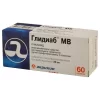Description
Sioformin Pharmacodynamics
Metformin belongs to the group of biguanides. It has hypoglycemic action. It provides reduction of both basal and postprandial blood plasma glucose concentrations. It does not stimulate insulin secretion and therefore does not lead to hypoglycemia.
The action of metformin is based on the following mechanisms:
– reduction of glucose production in the liver due to inhibition of gluconeogenesis and glycogenolysis;
– increased muscle sensitivity to insulin and, consequently, improved glucose absorption and utilization in the periphery;
– Inhibition of glucose absorption in the intestine.
Metformin through its action on glycogen synthase stimulates intracellular glycogen synthesis. Increases the transport capacity of all hitherto known membrane glucose transport proteins.
Has, regardless of its effect on plasma glucose concentration, a favorable effect on lipid metabolism, leads to lower concentrations of total cholesterol, low-density lipoprotein cholesterol and triglycerides.
Against the background of metformin administration in patients with diabetes, body weight either remains stable or decreases moderately.
Indications
Diabetes mellitus type 2, especially in overweight patients, for adequate control of plasma glucose concentration, when diet therapy and physical activity are ineffective:
– In adults as monotherapy or as part of combined therapy with other oral hypoglycemic agents and insulin;
– In children over 10 years as monotherapy or in combination with insulin. Prophylaxis of diabetes mellitus type 2 in patients with prediabetes mellitus type 2 with additional risk factors of development of diabetes mellitus type 2, in whom changes in lifestyle did not allow to achieve adequate glycemic control.
Contraindications
– Hypersensitivity to metformin or excipients of the drug;
– diabetic ketoacidosis, diabetic precoma, coma;
– renal impairment (creatinine clearance < 60 ml/min);
– acute conditions with risk of renal dysfunction: dehydration (e.g., diarrhea, vomiting), severe infectious diseases, shock;
– acute or chronic conditions accompanied by tissue hypoxia (cardiac or respiratory failure, recent myocardial infarction, shock);
– the period within 48 h before and 48 h after radioisotopic or radiological examinations with iodine-containing radiopaque agents (including angiography or urography) (intravenous administration of iodine-containing radiopaque agents can lead to renal dysfunction);
– the period within 48 h before and 48 h after surgical interventions;
– hepatic insufficiency, impaired liver function;
– lactoacidosis (including anamnesis);
– acute alcohol intoxication, chronic alcoholism;
– observance of a low-caloric diet (less than 1000 kcal per day);
– children under 10 years of age;
– pregnancy.
How to use and dosages.
- Inside.
- The dose and dosage regimen of the drug, as well as the duration of treatment are established by the attending physician, depending on the blood plasma glucose concentration.
- Adults
- Monotherapy or in combination therapy with other hypoglycemic agents for oral administration
- Recommended initial dose is 500 mg (1 tablet of Siofor 500) 2-3 times per day during or after main meals.
- In 10-15 days after the beginning of preparation its dose can be gradually increased depending on plasma glucose concentration up to average daily dose of 3-4 tablets of Siofor® 500. Gradual increase in the dose improves tolerability of the drug from the gastrointestinal tract.
- The maximum daily dose of metformin is 3000 mg divided into 3 doses.
- In case a patient is transferred to therapy with Siofor 500 from therapy with other hypoglycemic drugs, it is necessary to stop taking the latter and start taking Siofor 500 in the above doses.
- Simultaneous use with insulin
- Sioforn 500 and insulin may be combined to improve glycemic control. Standard initial dose is 500 mg (1 tablet of Siofor® 500) 2 to 3 times per day, with gradual dose increase at approximately one week intervals to the average daily dose of 3-4 tablets; the dose of insulin is determined on the basis of plasma glucose concentration.
- The maximum daily dose of metformin is 3000 mg divided into 3 doses.
- Elderly patients
- Due to possible renal dysfunction in elderly patients, the dose of Sioformin 500 is adjusted according to the creatinine concentration in plasma. Regular evaluation of renal function is necessary.
- Children from 10 to 18 years old
- Monotherapy and simultaneous use with insulin
- Standard initial dose is 500 mg (1 tablet of Siofor 500) once daily during or after main meals.
- In 10-15 days after initiation of the drug, a further gradual dose increase is possible, depending on the blood plasma glucose concentration. Gradual increase in the dose improves the drug tolerability in the gastrointestinal tract.
- Maximum daily dose of metformin for children is 2000 mg divided into 2-3 doses.
- When concomitant use with insulin, the dose of insulin is determined on the basis of plasma glucose concentration.
- Monotherapy in prediabetes.
- The usual dose is 1000-1700 mg per day after or during meals, divided into 2 doses. If a dose of 1700 mg of metformin is necessary, patients may be switched to a metformin dosage of 850 mg.
- Regular glycemic control is recommended to assess the need for further use of the drug.
- Patients with renal impairment
- Metformin may be used in patients with moderate renal insufficiency (creatinine clearance 45-59 ml/min) only in the absence of conditions that may increase the risk of lactoacidosis.
- Patients with creatinine clearance 45-59 ml/min: the initial dose is 500 mg or 850 mg once daily. The maximum daily dose is 1000 mg divided into 2 doses.
- Renal function should be closely monitored (every 3-6 months).
- If creatinine clearance is below 45 ml/min, the drug should be stopped immediately.





![Metformin (Siofor) 500 mg - [60 tablets]](https://mediscom.com.co/wp-content/uploads/2022/11/Sioformin-500mg-60.webp)




